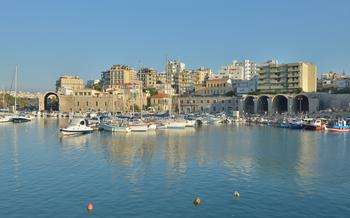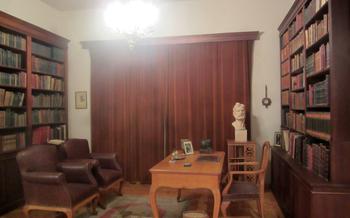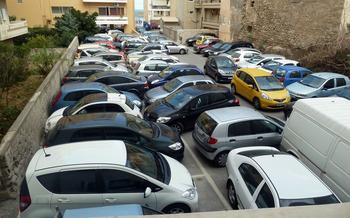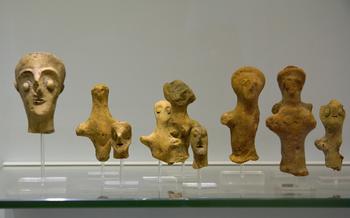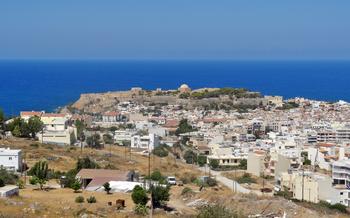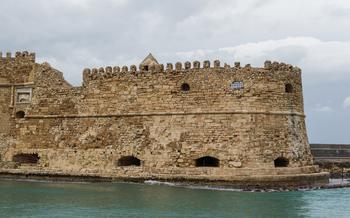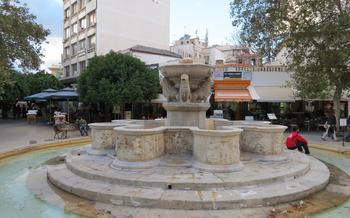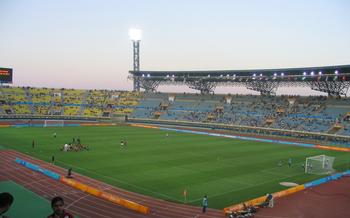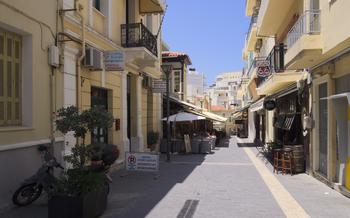
Heraklion Archaeological Museum
- Historical Background
- Location and Accessibility
- Museum's Collection
- Minoan Frescoes: A Glimpse into Minoan Life
- Other Museum Highlights
- Historical Context
- Guided Tours
- Museum Facilities
- Photography and Videography
- Dress Code and Etiquette
- Souvenirs and Gifts
- Nearby Attractions
- Local Cuisine
- Safety and Security
- Insider Tip: Uncovering the Secret Chamber of the Snake Goddess
Historical Background
Heraklion, the vibrant capital of Crete, boasts a rich and storied past, deeply intertwined with the Minoan civilization, the Venetian era, and the Ottoman occupation. The Heraklion Archaeological Museum stands as a testament to this rich tapestry of history, housing a treasure trove of artifacts that bring to life the grandeur and achievements of these ancient civilizations.
The Minoans, a sophisticated and enigmatic people, flourished on Crete from around 2700 to 1450 BC. Their advanced culture, with its impressive palaces, intricate writing system, and vibrant art, left an indelible mark on the island. The museum's collection of Minoan artifacts, including exquisite frescoes, sculptures, and pottery, offers a glimpse into their fascinating world.
During the Venetian period, from the 13th to the 17th century, Heraklion served as the capital of Crete. The Venetians transformed the city, leaving behind a legacy of impressive fortifications, elegant buildings, and a rich cultural heritage. The museum's collection includes artifacts from this era, showcasing the influence of Venetian art and architecture on Crete.
The Ottoman occupation of Crete, which lasted from the 17th to the 19th century, left its own unique imprint on the island. The museum houses artifacts from this period, providing insights into the challenges and triumphs of Cretans under Ottoman rule. The eventual liberation of Crete in 1898 marked a new chapter in the island's history, and the museum's collection chronicles this pivotal event.
Location and Accessibility
The Heraklion Archaeological Museum is conveniently located in the heart of Heraklion, the capital city of Crete. It is situated on Xanthoudidou Street, just a short walk from the city's central square, Eleftherias Square. The museum is easily accessible by foot, bicycle, or public transportation.
To get to the museum by public transportation, take bus route 1 or 2 from the Heraklion bus station and get off at the "Archaeological Museum" stop. The museum is also within walking distance from the Heraklion port, making it a convenient stop for cruise ship passengers.
For those arriving by car, there is limited street parking available in the surrounding area. However, it is recommended to use the public parking lot located a few blocks away on 25th August Street. Once parked, simply follow the signs to the museum, which is just a short walk from the parking lot.
The Heraklion Archaeological Museum is surrounded by several other notable attractions, making it an ideal starting point for exploring the city. The Venetian Fortezza, the Venetian Walls, and the Historical Museum of Crete are all within a short walking distance. Visitors can easily spend a day or two exploring the rich history and culture of Heraklion, starting with the Heraklion Archaeological Museum.
Museum's Collection
The Heraklion Archaeological Museum boasts a vast and impressive collection of artifacts that provide a glimpse into the rich history and culture of Minoan Crete. Among the highlights are the Minoan frescoes, which are considered some of the finest examples of ancient painting in the world. These vibrant and intricate frescoes depict a variety of scenes, including bull-leaping, religious rituals, and daily life. They offer valuable insights into Minoan society, their beliefs, and their artistic achievements.
Another significant part of the museum's collection is the collection of Minoan sculptures. These sculptures, which include both large-scale statues and smaller figurines, depict a variety of subjects, including gods, goddesses, animals, and humans. They demonstrate the skill and artistry of Minoan sculptors and provide further evidence of the sophistication of Minoan civilization.
The museum also houses a large collection of Minoan pottery. This pottery, which includes both functional and decorative pieces, is notable for its variety of shapes, styles, and decorations. It provides valuable information about Minoan technology, trade, and artistic traditions.
In addition to these highlights, the museum also displays a number of other notable artifacts, including the Arkalochori Axe, a bronze double-headed axe dating from the 17th century BC, and the Snake Goddess, a faience figurine of a goddess with snakes coiled around her body. These artifacts, along with the museum's extensive collection of Minoan frescoes, sculptures, and pottery, provide a comprehensive overview of Minoan culture and history.
Minoan Frescoes: A Glimpse into Minoan Life
The Heraklion Archaeological Museum is home to a remarkable collection of Minoan frescoes, vibrant and intricate artworks that offer a glimpse into the daily lives, religious beliefs, and cultural practices of this ancient civilization. These frescoes, painted on the walls of palaces and villas, depict a wide range of subjects, from bull-leaping and religious rituals to scenes of everyday life.
The bull-leaping frescoes are particularly striking, showcasing the athleticism and agility of the Minoans. These frescoes depict young men and women gracefully leaping over the horns of charging bulls, a dangerous and symbolic ritual that may have been associated with coming-of-age ceremonies or religious festivals.
Other frescoes showcase scenes of religious ceremonies, with Minoans offering sacrifices to their gods and goddesses. These frescoes provide valuable insights into the Minoan pantheon and their religious practices.
The frescoes also offer a glimpse into the everyday lives of the Minoans. They depict scenes of hunting, fishing, and farming, as well as social gatherings and celebrations. These frescoes reveal a vibrant and sophisticated society that valued art, music, and dance.
The techniques used to create these frescoes are also remarkable. The Minoans used a true fresco technique, painting on wet plaster with natural pigments. This technique resulted in vibrant and long-lasting colors that have survived for thousands of years.
The Minoan frescoes are not just beautiful works of art; they are also invaluable historical documents that provide a unique window into the culture and society of this ancient civilization.
Other Museum Highlights
Beyond the captivating Minoan frescoes, the Heraklion Archaeological Museum houses a treasure trove of other remarkable artifacts that provide a comprehensive insight into Minoan civilization. Among these are exquisite sculptures that depict deities, animals, and human figures, showcasing the Minoans' mastery of form and detail. The intricate pottery collection, with its diverse shapes, designs, and vibrant colors, offers a glimpse into the everyday life and craftsmanship of the Minoans. Equally impressive is the collection of jewelry, adorned with precious metals, gemstones, and intricate designs, reflecting the Minoans' love of adornment and artistry. These artifacts, along with many others, contribute to the museum's reputation as a world-renowned repository of Minoan culture and history.
Historical Context
The artifacts in the Heraklion Archaeological Museum offer a glimpse into the rich history of Crete and the Minoan civilization. The Minoans, who flourished on Crete from around 2700 to 1450 BC, were a highly advanced civilization that developed a unique culture and art form. Their maritime prowess and trading networks allowed them to influence other civilizations in the Mediterranean region.
The museum's collection provides valuable insights into the Minoan way of life, their religious beliefs, and their interactions with other cultures. The vibrant frescoes, intricate sculptures, and finely crafted pottery showcase the Minoans' artistic talents and technical skills. By studying these artifacts, we can gain a deeper understanding of the development of European civilization and the significant role played by the Minoans in shaping its trajectory.
Guided Tours
To fully appreciate the significance and beauty of the Heraklion Archaeological Museum's collection, consider booking a guided tour. Knowledgeable guides can provide valuable insights and explanations, bringing the artifacts to life and helping you understand the context and history behind them.
Different types of tours are available to suit your preferences and budget, including group tours, private tours, and audio guides. Group tours offer a cost-effective way to explore the museum with a knowledgeable guide, while private tours provide a more personalized experience with the undivided attention of your guide. Audio guides are a great option for independent travelers who prefer to explore at their own pace.
To book a guided tour, you can either reserve in advance online or inquire at the museum's information desk. Costs may vary depending on the type of tour and the number of participants. Whether you choose a guided tour or explore independently, the Heraklion Archaeological Museum offers a wealth of knowledge and treasures waiting to be discovered.
Museum Facilities
The Heraklion Archaeological Museum offers a range of facilities to enhance visitors' experience. A well-stocked gift shop provides a variety of souvenirs, from replicas of Minoan artifacts to books on Cretan history and culture. You can purchase postcards, magnets, and other mementos to cherish your visit.
For those seeking refreshments, a cozy cafe is located within the museum premises. Enjoy a cup of Greek coffee or a light snack while taking a break from exploring the exhibits. Restrooms are conveniently located throughout the museum, ensuring visitors' comfort.
The museum is committed to accessibility for all visitors. Wheelchair ramps and elevators provide easy access to all levels of the museum. Visitors with disabilities can also request assistance from the museum staff.
Before your visit, check the museum's website for the most up-to-date information on opening hours, ticket prices, and any special exhibitions or events. Plan your visit accordingly to make the most of your time at the Heraklion Archaeological Museum.
Photography and Videography
The Heraklion Archaeological Museum has specific policies regarding photography and videography within its premises. While visitors are permitted to take photographs for personal use, the use of tripods, flash photography, and professional filming equipment is strictly prohibited. This is to ensure the preservation of the artifacts and the overall integrity of the museum's environment.
Respecting these guidelines is crucial for maintaining the museum's sanctity and allowing all visitors to enjoy the exhibits without disruption. Instead of using flash photography, which can damage the delicate artifacts, visitors are encouraged to adjust their camera settings accordingly to capture the best possible images. For those interested in videography, it's advisable to contact the museum administration in advance to obtain the necessary permits.
Remember, your visit to the Heraklion Archaeological Museum is an opportunity to immerse yourself in the wonders of Minoan civilization and appreciate the intricate details of their artistic creations. By adhering to the museum's photography and videography policies, you can contribute to the preservation of this cultural heritage for future generations to cherish.
Dress Code and Etiquette
As you step into the hallowed halls of the Heraklion Archaeological Museum, it is essential to remember that you are entering a space of immense cultural and historical significance. Respect for the artifacts and the institution that houses them is paramount. Dress appropriately, opting for attire that is both comfortable and respectful of the museum's environment. Avoid revealing or overly casual clothing, as they may be deemed inappropriate. While capturing memories through photography is encouraged, always adhere to the museum's guidelines regarding flash photography and tripods. Be mindful of noise levels, speaking softly and refraining from engaging in loud conversations or disruptive behavior. Remember, silence can be a powerful tool in appreciating the museum's treasures and allowing others to do the same.
Souvenirs and Gifts
As you wander through the halls of the Heraklion Archaeological Museum, marveling at the wonders of Minoan civilization, you may feel inspired to take home a piece of this rich history. The museum's gift shop offers a treasure trove of souvenirs and gifts that are sure to delight history buffs and art enthusiasts alike.
Browse through a carefully curated selection of replicas, books, and educational materials that delve deeper into the fascinating world of the Minoans. Discover unique jewelry and pottery inspired by Minoan designs, allowing you to wear or display a piece of ancient history.
Support the museum's ongoing efforts to preserve and showcase Crete's cultural heritage by purchasing a souvenir. Your contribution helps ensure that future generations can continue to appreciate and learn from these remarkable artifacts.
Venture beyond the museum's gift shop and explore the vibrant streets of Heraklion for even more authentic souvenirs. Local artisans and craftsmen create beautiful handmade items, such as leather goods, woven textiles, and traditional ceramics, that capture the essence of Cretan culture.
Whether you choose to purchase a replica of a Minoan fresco, a piece of handcrafted jewelry, or a delectable treat from a local bakery, your souvenir will serve as a cherished reminder of your visit to Heraklion and the captivating history it holds.
Nearby Attractions
After immersing yourself in the wonders of the Heraklion Archaeological Museum, take some time to explore the other captivating attractions that Heraklion has to offer. Just a short walk away, you'll find the imposing Venetian Fortezza, a majestic fortress that once guarded the city from invaders. Its towering walls and intricate fortifications offer a glimpse into Heraklion's rich history and provide breathtaking panoramic views of the city and the surrounding landscape.
Continue your journey through time by strolling along the Venetian Walls, which once encircled the entire city. These impressive fortifications, built during the Venetian era, stand as a testament to the city's resilience and strategic importance. As you wander along the walls, you'll encounter charming alleys, hidden courtyards, and picturesque viewpoints that offer unique perspectives of Heraklion's cityscape.
To delve deeper into the history and culture of the region, visit the Historical Museum of Crete, located in the heart of the city. This captivating museum houses a vast collection of artifacts, documents, and exhibits that chronicle the island's rich past, from the Minoan era to the present day. Discover the stories of Crete's ancient civilizations, its struggles for independence, and its unique traditions through interactive displays, multimedia presentations, and captivating historical accounts.
Local Cuisine
Indulge in the delectable flavors of traditional Cretan cuisine during your stay in Heraklion. The island of Crete is renowned for its unique culinary traditions, influenced by its rich history and diverse geography. Begin your culinary journey with Dakos salad, a refreshing combination of barley rusks, ripe tomatoes, creamy feta cheese, and fragrant olive oil. Savor the Gamopilafo, a hearty wedding pilaf made with tender lamb or goat meat, aromatic rice, and a medley of vegetables. For a taste of the sea, try the Sfakiani pie, a savory pastry filled with fresh spinach, tangy cheese, and wild herbs, all baked to perfection.
Explore the charming streets of Heraklion to discover authentic tavernas and restaurants serving these delectable dishes. Engage with the friendly locals, who are always eager to share their culinary secrets and recommend hidden gems where you can indulge in the true flavors of Crete. Allow your taste buds to dance with the vibrant and aromatic flavors that define Cretan cuisine, a testament to the island's rich cultural heritage.
Safety and Security
Heraklion is a safe city to visit, with a low crime rate and friendly locals. However, as with any travel destination, it's important to take general safety precautions. Be aware of your surroundings, avoid isolated areas at night, and keep an eye on your belongings. The Heraklion Archaeological Museum takes the safety of its visitors and artifacts very seriously. Security measures are in place to protect the collection and ensure a safe environment for everyone. Visitors are encouraged to report any suspicious activity to museum staff.
Insider Tip: Uncovering the Secret Chamber of the Snake Goddess
As you wander through the captivating halls of the Heraklion Archaeological Museum, don't miss the hidden gem that lies tucked away from the main exhibits – the Secret Chamber of the Snake Goddess. This enigmatic chamber houses a remarkable collection of artifacts related to the Minoan Snake Goddess, a revered deity worshipped by the ancient Minoans.
The highlight of the chamber is a stunning serpentine figurine, meticulously carved from ivory and adorned with intricate details. Its mesmerizing gaze and sinuous form exude both power and grace, embodying the essence of the Snake Goddess.
Unveiling this hidden chamber is like embarking on a journey through time, connecting with the sacred beliefs and rituals of the Minoan civilization. It's a place where history comes alive, inviting you to unravel the mysteries of the Snake Goddess and her enduring legacy.

